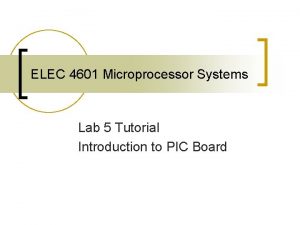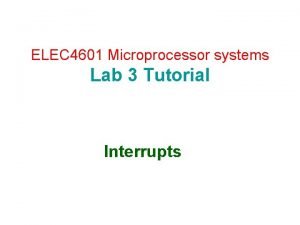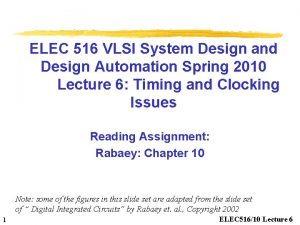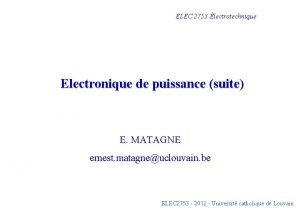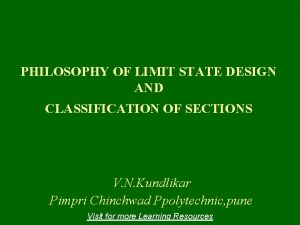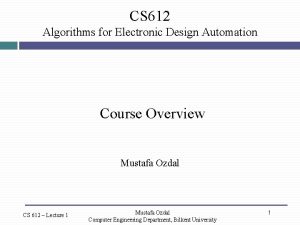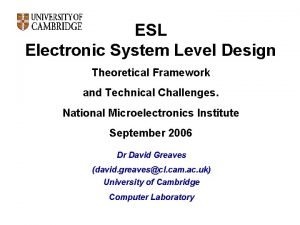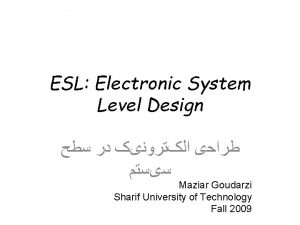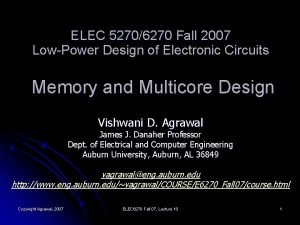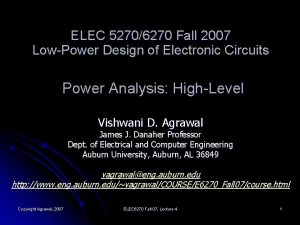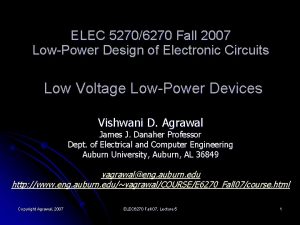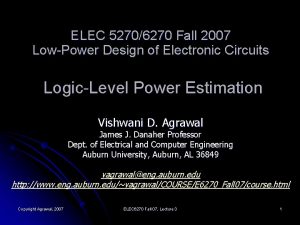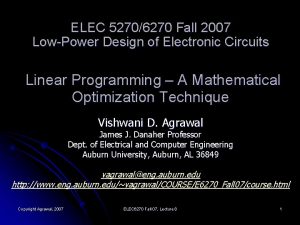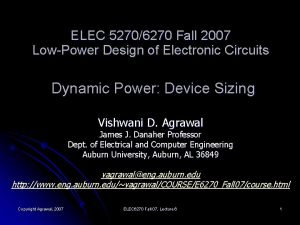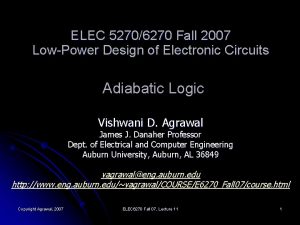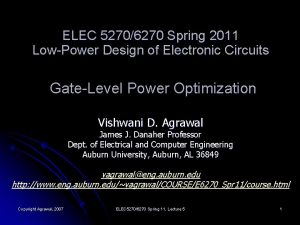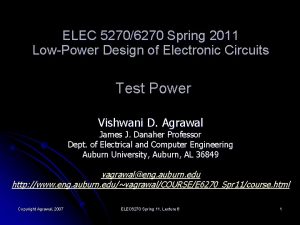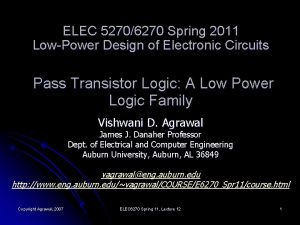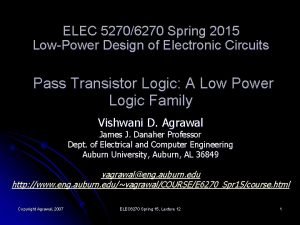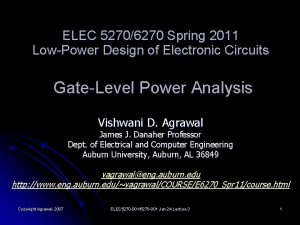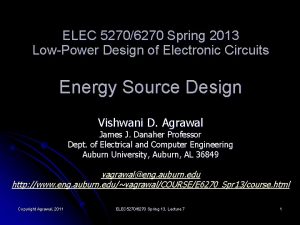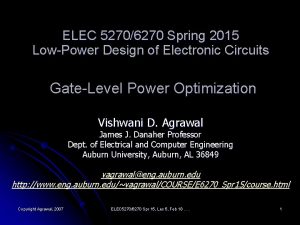ELEC 52706270 Fall 2007 LowPower Design of Electronic

















- Slides: 17

ELEC 5270/6270 Fall 2007 Low-Power Design of Electronic Circuits Dynamic Power: Device Sizing Vishwani D. Agrawal James J. Danaher Professor Dept. of Electrical and Computer Engineering Auburn University, Auburn, AL 36849 vagrawal@eng. auburn. edu http: //www. eng. auburn. edu/~vagrawal/COURSE/E 6270_Fall 07/course. html Copyright Agrawal, 2007 ELEC 6270 Fall 07, Lecture 6 1

Delay of a CMOS Gate capacitance Cg Intrinsic capacitance CMOS gate Cint CL Propagation delay through the gate: tp = 0. 69 Req(Cint + CL) ≈ 0. 69 Req. Cg (1 + CL /Cg), Cint ≈ Cg = tp 0 (1 + CL /Cg) tp 0 = intrinsic or unloaded delay Copyright Agrawal, 2007 ELEC 6270 Fall 07, Lecture 6 2

Req, Cg, Cint, and Width Sizing l l l Sizing: Keep L fixed, increase W by size factor S Req : equivalent resistance of “on” transistor for standard gate, proportional to L / W; reduces to Req / S Cg : standard gate capacitance, proportional to Cox. WL; increases to SCg Cint : intrinsic output capacitance ≈ Cg, for submicron processes tp 0 : intrinsic delay = 0. 69 Req. Cg; remains unchanged with sizing – is purely a function of the technology Copyright Agrawal, 2007 ELEC 6270 Fall 07, Lecture 6 3

Delay of a Gate Sized by Factor S tp = 0. 69 Req/S (SCg + CL) = 0. 69 Req. Cg (1 + CL/SCg) = tp 0 (1 + CL/SCg) Intrinsic delay of standard gate in technology Copyright Agrawal, 2007 Ratio of load capacitance to capacitance of sized gate ELEC 6270 Fall 07, Lecture 6 4

Effective Fan-out, F l Effective fan-out is defined as the ratio of the external load capacitance to the standard gate capacitance: F = CL/Cg tp Copyright Agrawal, 2007 = tp 0 (1 + CL /Cg) = tp 0 (1 + F ) ELEC 6270 Fall 07, Lecture 6 5

Sizing an Inverter Chain #1 (standard) Cg 1 #2 (size f 2) #N (size f. N) Cg 2 CL Cg 2 = f 2 Cg 1 tp 1 = tp 0 (1 + Cg 2 /Cg 1) tp 2 = tp 0 (1 + Cg 3 /Cg 2) tp = N Σ tpj = tp 0 j =1 Copyright Agrawal, 2007 N Σ (1 + Cgj+1/Cgj) j=1 ELEC 6270 Fall 07, Lecture 6 6

Minimum Delay Sizing Equate partial derivatives of tp with respect to Cgj , j = 2, 3, . . . , to 0: 1/Cg 1 – Cg 3/Cg 22 = 0, etc. or Cg 22 = Cg 1×Cg 3, etc. or Cg 2/Cg 1 = Cg 3/Cg 2, etc. i. e. , all stages are sized up by the same factor f with respect to the preceding stage: CL/Cg 1 = F = f N, tp = Ntp 0(1 + F 1/N) Copyright Agrawal, 2007 ELEC 6270 Fall 07, Lecture 6 7

Minimum Delay Sizing Equate partial derivatives of tp with respect to N to 0: d. Ntp 0(1 + F 1/N) ───── = 0 d. N i. e. F 1/N – F 1/N(ln F)/N = 0 or ln f = 1 → f = e = 2. 718 and N = ln F Copyright Agrawal, 2007 ELEC 6270 Fall 07, Lecture 6 8

Delays of Loaded Gates F = fan-out factor l Single stage, no sizing tp = tp 0 (1 + F) l Two-stage optimum sizing tp = 2 tp 0 (1 + √F) l N = ln F stage optimum sizing tp = tp 0 ln F (1 + N√F) l Copyright Agrawal, 2007 ELEC 6270 Fall 07, Lecture 6 9

Gate Delay Ratio of Intrinsic Delay Optimum delay Fanout factor, F Unsized Two-stage delay Optimum N N-stage delay 10 11 8. 3 2 8. 3 100 101 22 5 16. 5 1000 1001 65 7 24. 8 10000 10001 202 9 33. 1 J. M. Rabaey, A. Chandrakasan and B. Nikolić, Digital Integrated Circuits, Second Edition, Upper Saddle River, New Jersey: Pearson Education, 2003, pp. 205 -210. Copyright Agrawal, 2007 ELEC 6270 Fall 07, Lecture 6 10

Sizing for Energy Minimization Main idea: For a given circuit, reduce energy consumption by reducing the supply voltage. This will increase delay. Compensate the delay increase by transistor sizing. Ref: J. M. Rabaey, A. Chandrakasan and B. Nikolić, Digital Integrated Circuits, Second Edition, Upper Saddle River, New Jersey: Pearson Education, 2003, pp. 218 -219. Copyright Agrawal, 2007 ELEC 6270 Fall 07, Lecture 6 11

Sizing for Energy Minimization f 1 Cg 1 tp F CL = tp 0 [(1+f) + (1+F/f )] = tp 0(2+ f + F/f ) = CL/Cg 1 tp 0 ~ VDD/(VDD - Vth) Energy consumption, E=VDD 2 Cg 1[1+(1+f)+(f+F)] =VDD 2 Cg 1[2+2 f+F] Copyright Agrawal, 2007 ELEC 6270 Fall 07, Lecture 6 12

Holding Delay Constant Reference circuit: f = 1, supply voltage = Vref l Size the circuit such that the delay of the new circuit is smaller than or equal to the reference circuit: l tp tp 0(2+f+F/f ) VDD ── = ──── = ── tpref tp 0 ref (3+F ) Vref Copyright Agrawal, 2007 Vref -Vth 2+f+F/f ───── ≤ 1 VDD -Vth 3+F ELEC 6270 Fall 07, Lecture 6 13

Supply Voltage Vs. Sizing 3. 5 F =1 VDD (volts) 3. 0 Vref = 2. 5 V Vth = 0. 5 V 2 2. 5 5 fopt ≈ √F 2. 0 1. 5 10 1. 0 1 Copyright Agrawal, 2007 2 3 4 ELEC 6270 Fall 07, Lecture 6 5 6 f 14

Energy E VDD 2 2 + 2 f + F ── = ────── Eref Vref 2 4+F Copyright Agrawal, 2007 ELEC 6270 Fall 07, Lecture 6 15

Normalized Energy Vs. Sizing Normalized Energy 1. 5 2 1. 0 5 fopt ≈ √F 0. 5 10 1 Copyright Agrawal, 2007 Vref = 2. 5 V Vt = 0. 5 V F =1 2 3 4 ELEC 6270 Fall 07, Lecture 6 5 6 f 16

Summary l l Device sizing combined with supply voltage reduction reduces energy consumption. For large fan-out energy reduction by a factor of 10 is possible. An exception is F = 1 case, where the minimum size device is also the most effective one. Oversizing the devices increases energy consumption. Copyright Agrawal, 2007 ELEC 6270 Fall 07, Lecture 6 17
 Elec 4601
Elec 4601 Elec4601
Elec4601 Elec service plus
Elec service plus Pattern recognition
Pattern recognition Elec
Elec Elec
Elec Elec
Elec Superposition electric circuits
Superposition electric circuits Is the electronic exchange of money or scrip
Is the electronic exchange of money or scrip Electronic news gathering and electronic field production
Electronic news gathering and electronic field production Design of gantry girder as per is 800 2007
Design of gantry girder as per is 800 2007 Cs 612
Cs 612 System-level design
System-level design Maziar goudarzi
Maziar goudarzi Cara mengaktifkan macro di excel 2010
Cara mengaktifkan macro di excel 2010 Regression analysis excel 2007
Regression analysis excel 2007 Mental health act (2007)
Mental health act (2007) Delhi fire service act
Delhi fire service act
